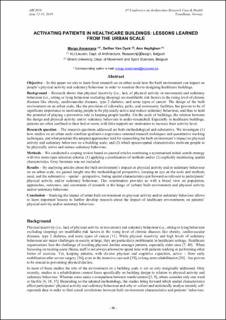| dc.description.abstract | Objective – In this paper we aim to learn from research on an urban scale how the built environment can impact on people’s physical activity and sedentary behaviour in order to translate this to designing healthcare buildings.
Background – Research shows that physical inactivity (i.e., lack of physical activity or movement) and sedentary behaviour (i.e., sitting or lying behaviour excluding sleeping) are modifiable risk factors in the rising level of chronic diseases like obesity, cardiovascular diseases, type 2 diabetes, and some types of cancer. The design of the built environment on an urban scale, like the provision of sidewalks, parks, and community facilities, has proven to be of significant importance in motivating people to be physically active and reduce sedentary behaviour, and thus to hold the potential of playing a preventive role in keeping people healthy. On the scale of buildings, the relation between the design and physical activity and/or sedentary behaviour is under-researched. Especially in healthcare buildings, patients are often confined to their bed or room, with little support nor motivation to increase their activity level.
Research question – The research questions addressed are both methodological and substantive. We investigate (1) how studies on an urban scale combine qualitative experience-oriented research techniques and quantitative tracking techniques, and what potential the adopted approaches hold for researching the built environment’s impact on physical activity and sedentary behaviour on a building scale; and (2) which spaces/spatial characteristics motivate people to be physically active and reduce sedentary behaviour.
Methods – We conducted a scoping review based on journal articles combining a systematised initial search strategy with two more open selection criteria: (1) applying a combination of methods and/or (2) explicitly mentioning spatial characteristics. Grey literature was not included.
Results – By analysing articles about the built environment’s impact on physical activity and/or sedentary behaviour on an urban scale, we gained insight into the methodological perspective, keeping an eye on the tools and methods used, and the substantive – spatial – perspective, listing spatial characteristics put forward as relevant to participants’ physical activity and/or sedentary behaviour. This combination provides us with a broad view on population, approaches, outcomes, and constraints of research at the hinge of (urban) built environment and physical activity and/or sedentary behaviour.
Conclusion – Studying the impact of urban built environment on physical activity and/or sedentary behaviour allows to learn important lessons to further develop research about the impact of healthcare environments on patients’ physical activity and/or sedentary behaviour. | |

